|
|
| The
Andalusian |
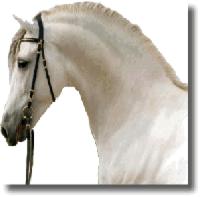 |
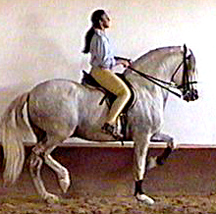 |
CHARACTERISTICS
Muscular in build, the overall picture of the
Andalusian is a horse of great beauty and balance. Typically he stands between
15 and 16.2 hands. Gray and bay coats are dominant and others are admissible in
Andalusian Horse Associations. In Spain, only grey, bay and black are accepted
by the studbook -- no chestnuts or other-colored horses. |
HEAD
Large, with a straight or subconvex profile. The
forehead is very wide with large dark eyes. Nostrils are large; ears are
medium, well placed, separated and very mobile; jaw is ample and muscled, with
a generous and discrete arch at the edge.
The neck is proportionate and well tied in. It is
elegant, though heavy, with an abundant mane. The throatlatch is clean; the
crest is well developed. |
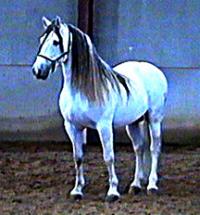 |
BODY
The withers are very round and ideally the
shoulders should be long and sloping. The back is strong and short coupled; the
chest is broad and strong; the croup is rounded; the tail is set low, lies
close to the body, and is abundant and long; and ideally, the hind quarters are
strong and lean.
The legs are strong and clean cut. They have
straight, flat bones and large joints. The cannons are short; pasterns sloping
and of good size, and the hooves are round, compact and sturdy.
ACTION
Movement is agile, elevated, extended, harmonious
and cadenced. The Andalusian is perfectly suited for dressage and "airs
above the ground", war horse, bullfighter's horse or western cattle horse.
He is fiery and proud, but at the same time docile and tractable. He is showy,
elegant, strong and bold. His walk is showy, trot is high-stepping and
impulsive, and his canter is smooth and spectacular. |
 |
TEMPERAMENT
These are horses with easy response to command
and very sensitive mouths, resulting in a mount that is obedient and of
extraordinary comfort. They are temperate and hardy; noble and docile. They
learn rapidly and participate intimately with their riders.
 |
HISTORY
Although there is much speculation regarding
which is the most ancient horse breed, it is clear that the Spanish horse was
the first to be handled and ridden by men. Cave paintings in the Iberian
Peninsula, dated at approximately 5,000 BC, show horses being led by men.
|
The Andalusian is one of the three foundation
breeds of modern horses, and eighty percent of all modern breeds trace at least
part of their breeding to the Andalusian. His influence is especially noted in
the Lipizzan, Friesian, Connemara, Cleveland Bay, Welsh Cob, and most American
breeds.
| His forefathers were the
native Spanish horse, the Sorraia Pony (descendant of the Asian Wild Horse and
the Tarpan) and the Barb. He, along with his brother breed the Lusitano,
evolved in Spain during the Muslim occupation between 711 and 1492, although
his prototype was depicted in cave paintings dating from 20,000 to 30,000 BC.
He was the premier war horse, preferred not only by Spanish conquistadors, but
also by Julius Caesar, Hannibal and Richard I. |
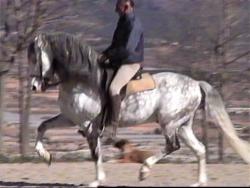 |
In the 1700's, the Andalusian fell from grace
when sleeker horses used for hunting and racing became the fad. A plague,
followed by famine, almost wiped out what was left of the breed. Fortunately,
the Carthugian Monastery, in a mountainous area of Spain, continued to breed
quality horses, and today the most beautiful and pure of the Spanish horses are
known as caballos Cartujanos.
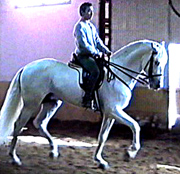 |
Because of the rarity of the
breed, the Spanish government placed an embargo on their export for over 100
years. In the 1960's, the ban was lifted, and Andalusians are once again found
throughout the world. |
For more information, contact the
International Andalusian Horse Association.
This article was kindly provided by Michelle
Staples, Staples Stables
Pictures compliments of International
Andalusian Horse Brokers of Spain. For more information and pictures, including
tips on "How to buy a Horse in Spain", go to
www.miriamfrenk.com
|

